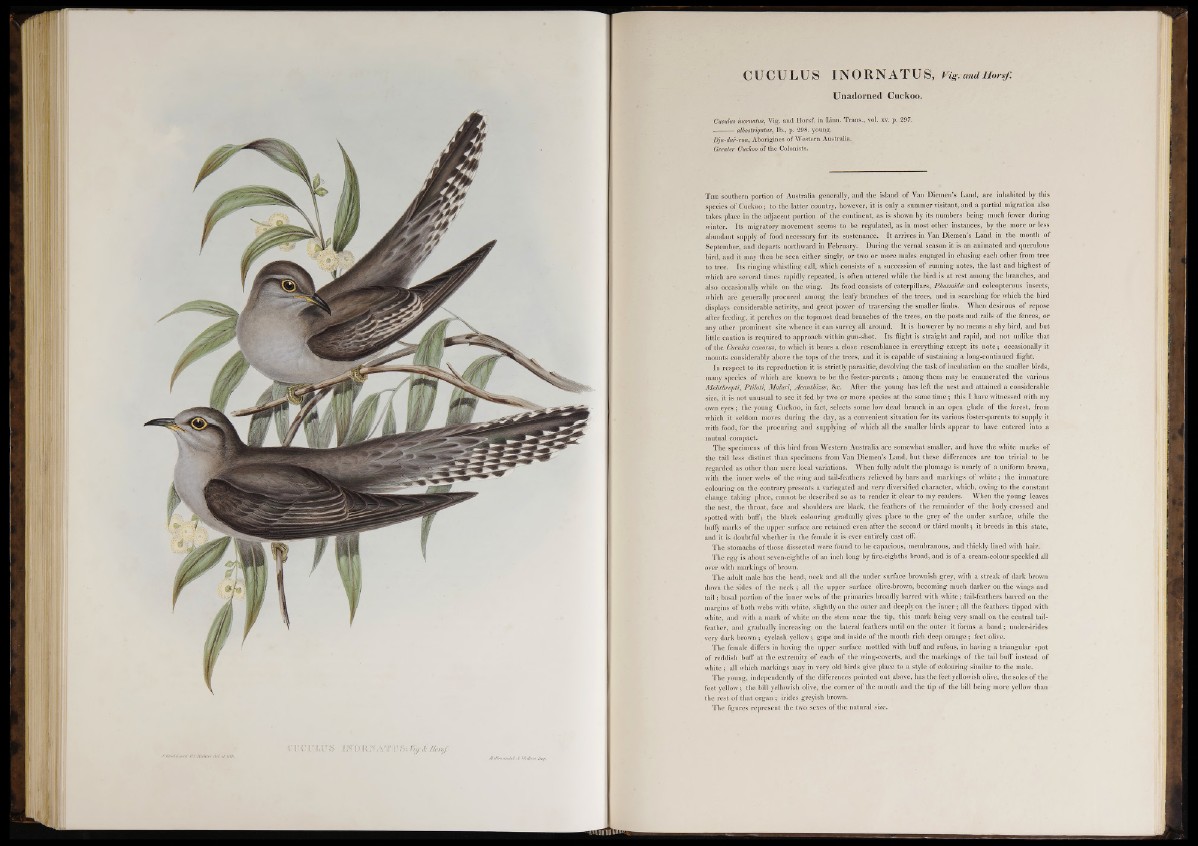
CUCULUS INORNATUS, n g . and Horsf.
Unadorned Cuckoo.
Cuculus inornatus, Vig. and Horsf. in Linn. Trans., vol. xv. p. 297.
albostrigatus, lb., p. 298. young.
Dju-dwr-rm, Aborigines of Western Australia.
Greater Cuckoo of the Colonists.
T h e southern portion of Australia generally, and the island o f Van Diemen’s Land, are inhabited by this
species of Cuckoo; to the latter country, however, it is only a summer visitant, and a partial migration also
takes place in the adjacent portion o f the continent, as is shown by its numbers being much fewer during
winter. Its migratory movement seems to be regulated, as in most other instances, by the more or less
abundant supply of food necessary for its sustenance. It arrives in Van Diemen’s Land in the month of
September, and departs northward in February. During the vernal season it is an animated and querulous
bird, and it may then be seen either singly, or two or more males engaged in chasing each other from tree
to tree. Its ringing whistling call, which consists o f a succession of running notes, the last and highest of
which are several times rapidly repeated, is often uttered while the bird is at rest among the branches, and
also occasionally while on the wing. Its food consists o f caterpillars, P/mmidce and coleopterous insects,
which are generally procured among the leafy branches of the trees, and in searching for which the bird
displays considerable activity, and great power of traversing the smaller limbs. When desirous o f repose
after feeding, it perches on the topmost dead branches o f the trees, on the posts and rails o f the fences, or
any other prominent site whence it can survey all around. It is however by no means a shy bird, and but
little caution is required to approach within gun-shot. Its flight is straight and rapid, and not unlike that
o f the Cuculus canorus, to which it bears a close resemblance in everything except its note; occasionally it
mounts considerably above the tops of the trees, and it is capable of sustaining a long-continued flight.
In respect to its reproduction it is strictly parasitic, devolving the task of incubation on the smaller birds,
many species of which are known to be the foster-parents ; among them may be enumerated the various
Melithrepti, Ptiloti, Maluri, Acanthizce, &c. After the young has left the nest and attained a considerable
size, it is not unusual to see it fed by two or more species at the same time ; this I have witnessed with my
own eyes; the young Cuckoo, in fact, selects some low dead branch in an open glade of the forest, from
which it seldom moves during the day, as a convenient situation for its various foster-parents to supply it
with food, for the procuring and supplying of which all the smaller birds appear to have entered into a
mutual compact.
The specimens of this bird from Western Australia are somewhat smaller, and have the white marks of
the tail less distinct than specimens from Van Diemen’s Land, but these differences are too trivial to be
regarded as other than mere local variations. When fully adult the plumage is nearly of a uniform brown,
with the inner webs of the wing and tail-feathers relieved by bars and markings o f white ; the immature
colouring on the contrary presents a variegated and very diversified character, which, owing to the constant
change taking place, cannot be described so as to render it clear to my readers. When the young leaves
the nest, the throat, face and shoulders are black, the feathers of the remainder o f the body crossed and
spotted with buff; the black colouring gradually gives place to the grey o f the under surface, while the
buffy marks o f the upper surface are retained even after the second or third moult; it breeds in this state,
and it is doubtful whether in the female it is ever entirely cast off.
The stomachs of those dissected were found to be capacious, membranous, and thickly lined with hair.
The egg is about seven-eighths o f an inch long by five-eighths broad, and is of a cream-colour speckled all
over with markings of brown.
The adult male has the head, neck and all the under surface brownish grey, with a streak o f dark brown
down the sides of the neck ; all the upper surface olive-brown, becoming much darker on the wings and
ta il; basal portion o f tire inner webs of the primaries broadly barred with white; tail-feathers barred on the
margins of both webs with white, slightly on the outer and deeply on the inner; all the feathers tipped with
white, and with a mark of white on the stem near the tip, this mark being very small on the central tail-
feather, and gradually increasing on the lateral feathers until on the outer it forms a band; under-irides
very dark brown ; eyelash yellow; gape and inside of the mouth rich deep orange; feet olive.
The female differs in having the upper surface mottled with buff and rufous, in having a triangular spot
o f reddish buff at the extremity of each of the wing-coverts, and the markings o f the tail buff instead of
white ; all which markings may in very old birds give place to a style o f colouring similar to the male.
The young, independently of the differences pointed out above, has the feet yellowish olive, the soles o f the
feet yellow; the bill yellowish olive, the corner o f the mouth and the tip of the bill being more yellow than
the rest of that organ ; irides greyish brown.
The figures represent the two sexes o f the natural size.